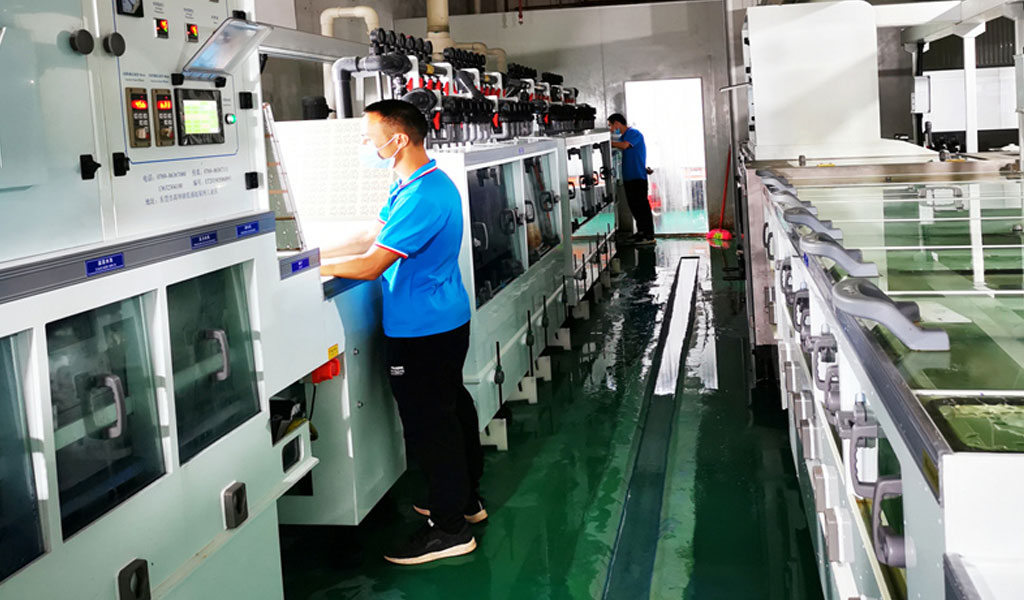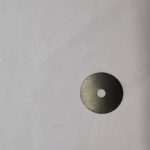With the development of PCB industry, the impedance requirements of various wires are getting higher and higher, which inevitably requires stricter control of wire width.
In order to enable the china metal etching company‘s engineering management personnel, especially the process engineering personnel responsible for the etching process, to have a certain understanding of the etching process, this training material is written to help production management and monitoring, thereby improving the quality of our products.
Basic principles of etching machine
1) Purpose of etching:
The purpose of etching is to etch away the unprotected non-conductor copper part of the circuit board with patterns made in the previous process to form a circuit.
Etching includes inner layer etching and outer layer etching. The inner layer uses acid etching, and wet film or dry film is the resist; the outer layer uses alkaline etching, and tin-lead is the resist.
2) Basic principles of etching reaction
I. Acidic copper chloride etching solution
- Characteristics
-Etching speed is easy to control, and the etching solution can achieve high etching quality under stable conditions
-Large amount of copper etching
-Etching solution is easy to regenerate and recycle
- Main reaction principle:
During the etching process, CU2+ is oxidizing and oxidizes the copper on the board surface into CU+: Cu+ CuCl2→2CuCl
The generated CuCl is insoluble in water. In the presence of excess chloride ions, it generates soluble complex ions: 2CuCl+4Cl-→2[CuCl3]2-
As the reaction proceeds, CU+ increases, and the copper etching ability decreases. The etching solution needs to be regenerated to convert CU+ into CU2+. There are several methods of regeneration: regeneration with oxygen or compressed air (low reaction rate), chlorine regeneration (fast reaction, but toxic), electrolytic regeneration (copper can be directly recovered, but requires electrolytic regeneration equipment and high power consumption), sodium hypochlorite regeneration (high cost, inherently dangerous), hydrogen peroxide regeneration (fast reaction rate, easy to control).
Reaction: 2CuCl+2HCl+H2O2→2CuCl2+2H2O
Automatic control addition system: automatic continuous production is achieved by controlling the etching speed, the addition ratio of hydrogen peroxide and hydrochloric acid, specific gravity and liquid level, temperature and other items.
Principle of etching process:
In a professional sense, the principle of etching refers to a controlled corrosion behavior of metals according to design and process requirements through professional etching machines. Through this controlled chemical processing, the design requirements of certain specific occasions can be met, which are not achievable by traditional mechanical processing methods. Metal chemical etching corrosion, in more occasions, refers to the chemical loss caused by chemical damage of metals in the natural environment. Therefore, the widely accepted definition of metal corrosion is: the chemical loss of metals caused by the contact between metals and the surrounding environment medium and the chemical or electrochemical reaction with it, resulting in the destruction and deterioration of metals. From this definition, various corrosion of metals is actually the chemical loss of metals. There are four popular expressions for the chemical loss of metals: chemical corrosion, chemical etching companies, chemical milling and chemical texture etching. These four expressions can be understood from the following aspects:
Etching equipment
Chemical corrosion: Chemical corrosion is a common phenomenon and process of metal chemical loss, including the commonly said metal damage corrosion in various corrosive environments, and also includes corrosion using chemical methods for controlled processing. From the perspective of the whole process, it includes both uncontrolled corrosion and controlled etching. It is a general term for metal chemical loss and a chemical loss behavior of metals in various chemical corrosive media. Many etching machine manufacturers use this etching method.
Chemical etching: Chemical etching is very targeted, which means controlled corrosion. It is a controllable processing method for metals through chemical methods. Chemical etching can be divided into chemical milling and chemical texture etching according to the surface effect after etching and the processing requirements.
Chemical milling: Chemical milling has the same meaning as mechanical milling, but the processing method is different. Chemical milling requires the surface after chemical etching to have the highest possible surface smoothness, the lowest possible surface roughness, and the highest possible etching accuracy.
Chemical texture etching: Chemical texture etching refers to the surface after chemical etching, which presents a surface effect with a certain degree of roughness, and the size of this roughness can be adjusted within a certain range by controlling the chemical and physical indicators of the PCB Etching process. These chemical indicators include: the type of corrosive agent used and the concentration ratio between them; physical indicators include: etching temperature, etching time and etching method.
Specific process of chemical etching process:
- Step 1: Cleaning treatment: Its purpose is to clean all kinds of stains on the surface of the blank of the part to be corroded, so as to ensure that the anti-corrosion layer can adhere to the metal surface uniformly and keep the etching speed uniform. Commonly used cleaning treatment methods include: organic solvent cleaning, alkaline chemical cleaning, acid chemical cleaning, ultrasonic cleaning and electrolytic cleaning. During use, they can be selected according to the type of metal material of the part and the degree of contamination on the surface of the part.
- Step 2: Anti-corrosion treatment: Its purpose is to protect those surfaces that do not need corrosion processing, so that the metal surface that needs corrosion processing is completely exposed and corroded by the corrosive agent suitable for the metal material. This process requires: the anti-corrosion material must adhere firmly to the metal surface, and the anti-corrosion layer will not fall off during the entire corrosion process. Anti-corrosion treatment mainly includes: screen printing anti-corrosion technology, photographic chemical anti-corrosion technology, pad printing anti-corrosion technology, graphic electroplating anti-corrosion technology, laser lithography anti-corrosion technology and scratching anti-corrosion layer technology, etc.
- Step 3: Corrosion processing: It is the process of placing the corroded metal parts into the corrosion tank for corrosion processing after the corrosion protection pattern is made according to the requirements of the drawings. In this process, the main controls are: corrosive agent concentration, corrosion temperature, etching time, etc. Metal corrosion processing can be divided into five basic types according to the requirements of the drawings, namely: overall corrosion, selective corrosion, multi-step corrosion, taper corrosion and chemical cutting. Metal full corrosion + requires corrosion protection treatment, and the parts can be corroded after cleaning.
- Step 4: Remove the corrosion protection layer: After the parts are qualified after corrosion, use solvents, alkali solutions or other cleaning agents to remove the corrosion protection layer on the surface of the parts.

We Can Take Care Of Your Metal Etching Needs.
BE-CU metal etching china company’s strength lies in our investment in chemical etching production line. Chemical etching production line are the foremost innovation to the metal etching industry.
The programmability of Chemical etching production line gives us quick and accurate repeatability. This constant replication allows for better finishes, tighter tolerances and most importantly – faster cycles for metal forming.
By engaging our etching company, you can also get the much-needed support to design your part for any specific purpose. Our team can provide custom design tips, such as ensuring consistent wall thickness and avoiding overly thick sections that can sink.
Are you designing new products for projects companies? We can help! Here at BE-CU Metal Etching China Company, we offer a reasonably priced rapid metal etching service that will allow you to make an amazing prototype that will impress your clients. Get a free project review here so we can get started for your metal etching products!
- Photo Etching for Medical Use

- Photo Etching for Metal Sign

- Photo Etching for Jewelry

- Ferric Chloride Etching Stainless Steel

- The Best Acid for Etching Steel

- The Principle And Process Flow Of PCB Etching Machine

- In The Localization Of Wafer Foundry Equipment, Etching Machines Stand Out

- How Important is the Blind Hole Rate of Filter Screens?

- The whole process of stainless steel sheet etching

- What is the Role of Aperture Diaphragms in the Field of Optics?

